News
Dive Notes from a Small Island: Part 3 – Ireland & Northern Ireland
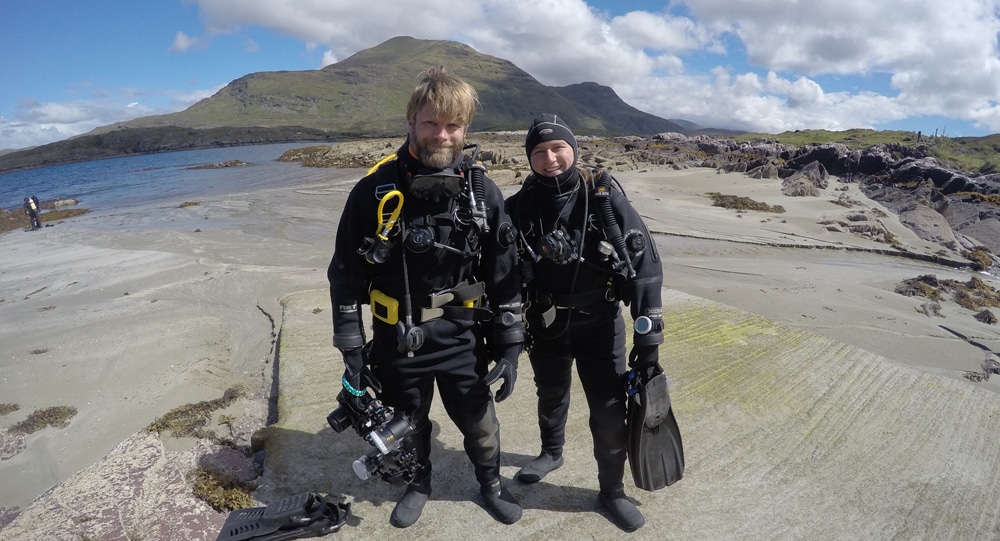
Having heard many great things about the diving in both Ireland and Northern Ireland and having the whole of August still ahead of us, we thought it would be rude not to go and investigate the diving on our neighbouring island of Ireland. Setting off from Holyhead on Sunday (sadly no diving in north Wales due to the weather, again!), we arrived in Dublin for some pints of Guinness and some city sightseeing. On the Monday we began our scenic tour around the wild Atlantic way, exploring the Irish countryside. Ireland is stunningly beautiful, if a little windy, and we got a lovely weather window for diving with Scubadive West, in County Galway.
Dive 7: Scubadive West house reef (“The 60 Footer”)
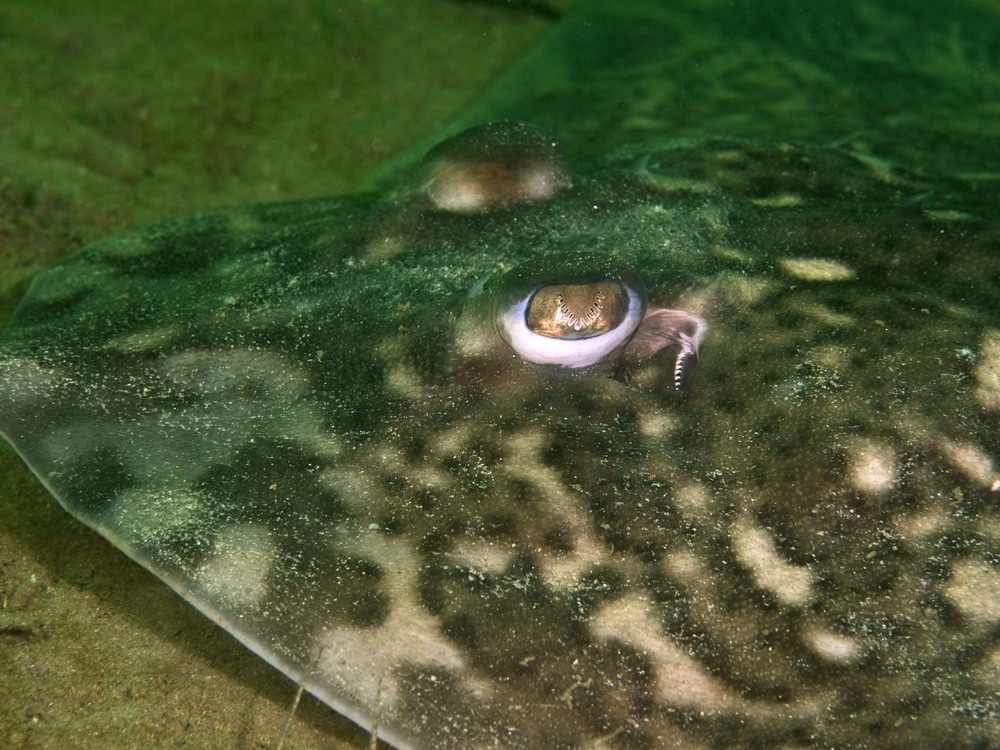
Site description:
Scubadive West is located in the stunning Little Killary Fjord. The dive center is well equipped and has friendly and informative staff, the house reef is accessible via the dive shop slipway and costs €10 per diver for access (boat dives are available on the weekends).
The house reef starts at the slipway which leads into a small sandy area sheltered by the kelp covered rocks, a channel in the rocks leads to “The 60 Footer” wreck, 30m out on a heading of 40°. The wreck is a 19m long, 6m wide wooden hulled former mussel tender and fishing vessel which sank while under tow in 2011. It now lies in 17m in the Little Killary Fjord and is covered in spectacular amount of life. After a thorough look around the wreck it is possible to continue along a line from the bow to some old scaffolding, which has huge numbers of tube worms growing on it. From here you can backtrack to the wreck and take a 270° heading back to the reef. Once beside the reef there are some old scuba cylinders with lobsters hiding in them, keeping the reef left, swim round the kelp covered rocks, over a small seagrass patch and back to the sandy area in front of the slipway to surface.
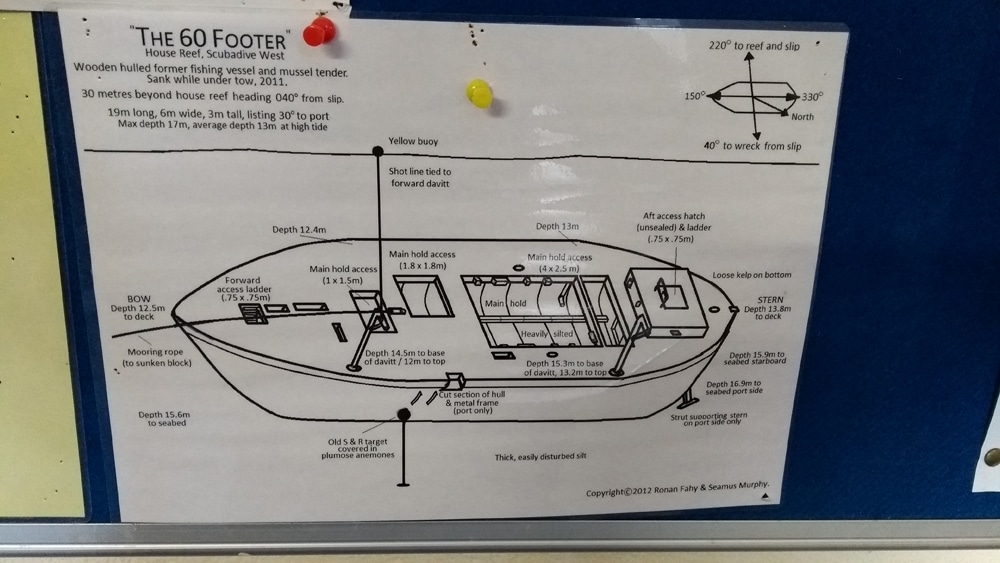
The Dive:
We arrived just after low tide and were joined by a keen young diver, Magnus, who was familiar with the shore dive and offered to guide us round. We waded out on the sand patch and did a surface swim over the shallow kelp covered rocks to the far side of the reef until we had a few meters depth to make our descent. The visibility was much better than any of our dives so far and we were very pleasantly surprised by the amount of life immediately visible on the sandy, silty bottom, such as long legged spider crabs, burrowing anemones and a thornback ray. The wreck was at about 14m and covered in life, huge plumose anemones, dead men’s fingers, crabs, lobsters, a shy conger eel and a sleeping dogfish. We explored the wreck and then headed over to see the organ pipe worms on the scaffolding, which were incredibly prolific and colourful. The rest of the dive was spent bimbling round the shallows near the reef looking for macro life, like the sea lemon nudibranch, pipefish, butterfish and a Yarrell’s blenny. Magnus was a great guide and I thought 75 minutes went by incredibly fast with so much to see. This is one of the best shore dives I have done in temperate waters!

Mike’s thoughts:
I had high expectations of diving in Ireland and this site did not disappoint. Much like our shore dives at Porthkerris in Cornwall, entry and exit were very convenient with parking and a full service dive center just meters from the shore. For an easy temperate water shore dive, the variety and abundance of life here was truly outstanding. From the scallops, crabs, gobies and dragonets in the sandy bottom to the anemones and tubeworms on the structures hardly a minute went by without something new to look at. I was especially happy to see my first dogfish up close as well. The only way to improve our dive for me would have been to wait for the tide to be a bit higher so that we could have seen more of the seagrass and kelp beds just off of the shore. As it was, I did manage to spot a pipefish in the seagrass on our way back in. With this much life right off the shore, I could only wonder at how much else there must be to see at the 50+ dive sites in the local area.
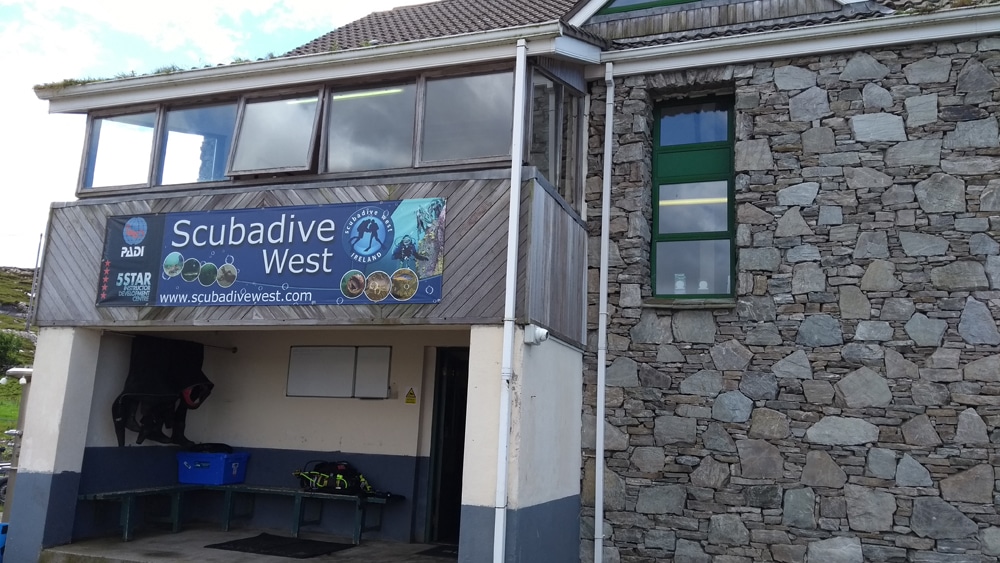
After being thoroughly impressed by Ireland’s diving we headed to Northern Ireland to do a boat dive on Rathlin Island with Richard at Aquaholics. The north coast is stunning with many National trust sites and Mike and I found ourselves getting very excited about the next days diving when we arrived and caught sight of Rathlin Island for the first time. On the morning of the dive we met at Ballycastle marina and got onto the Aquaholics catamaran and were introduced to our fellow divers. With some swell and a spring tide our first dive was on the sheltered south side of the island, before heading round to the wall on the north.
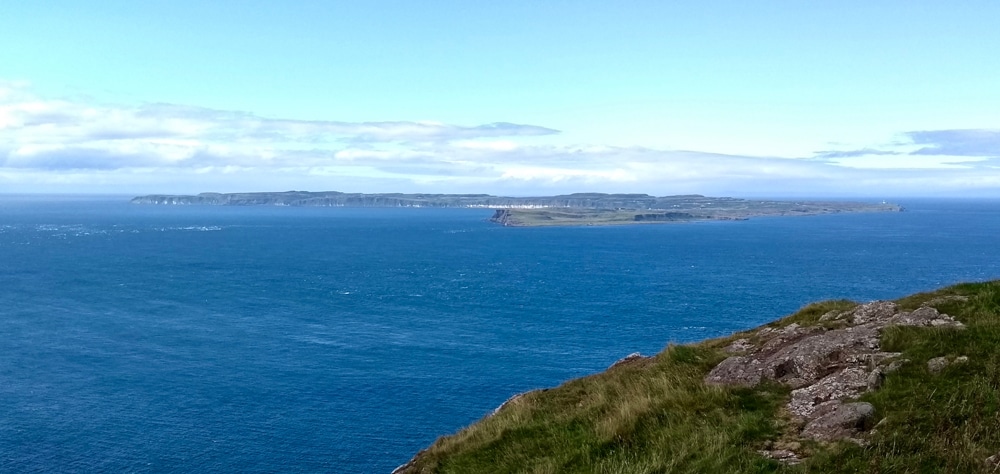
Dive 8: Sronlea Head, Church Bay, Rathlin Island
Site description:
Tucked in against the sheltered south facing cliffs the first dive of the day was on a rocky reef characterised by a sloping rock and boulder reef, covered in kelp down to 12m. The slope then continued gently down to 30+m, with the area known for having rich macro life and some rare species not found outside of this area.
The Dive:
The dive was planned as a gentle drift with the tide and on our descent through the kelp we found there was little current and we made our way down to about 22m based on the recommendation of our skipper Richard. It was a fantastic dive with excellent visibility and vast amounts of macro life, that had us stopping every meter to photograph a new nudibranch or cup-coral. We didn’t even make it to the main part of the dive site as we were so wrapped up in spotting all the life on the rocks and I spent a very enjoyable 55mins geeking out on this incredible site.
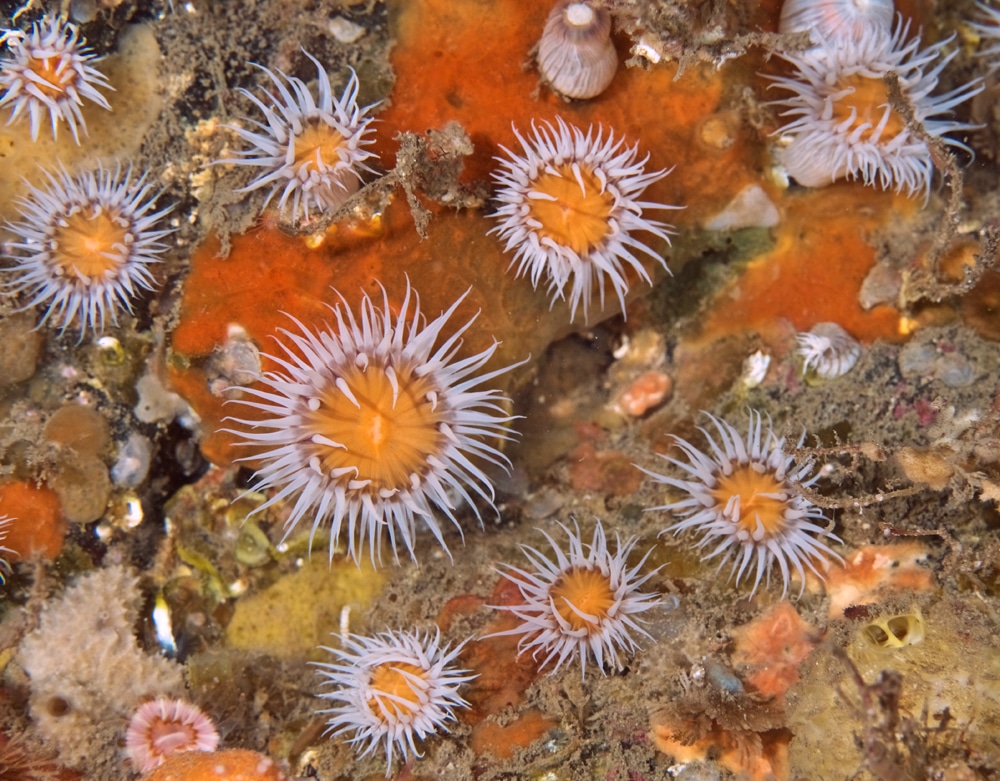
Mike’s thoughts:
The visibility for our dive was great and I enjoyed our relaxing drift along the rubbled slope. Although not quite as easy to spot as their brightly-colored tropical cousins, the nudibranch life in this area was definitely a highlight for me. We managed to spot five different species on the dive, which I thought was nice considering we only drifted for about 100 meters from the drop off point. I was also happy that my critter-spotting eyes were improving. The greenish waters all around the UK and Ireland make the general panorama a bit monochrome, so you really have to train your eyes to adapt and a learn a bit about various creatures’ preferred habitats to appreciate all of the life that is present. A dive torch is a necessity and I was quite lucky to have my friendly torch-wielding, critter-spotting buddy along.
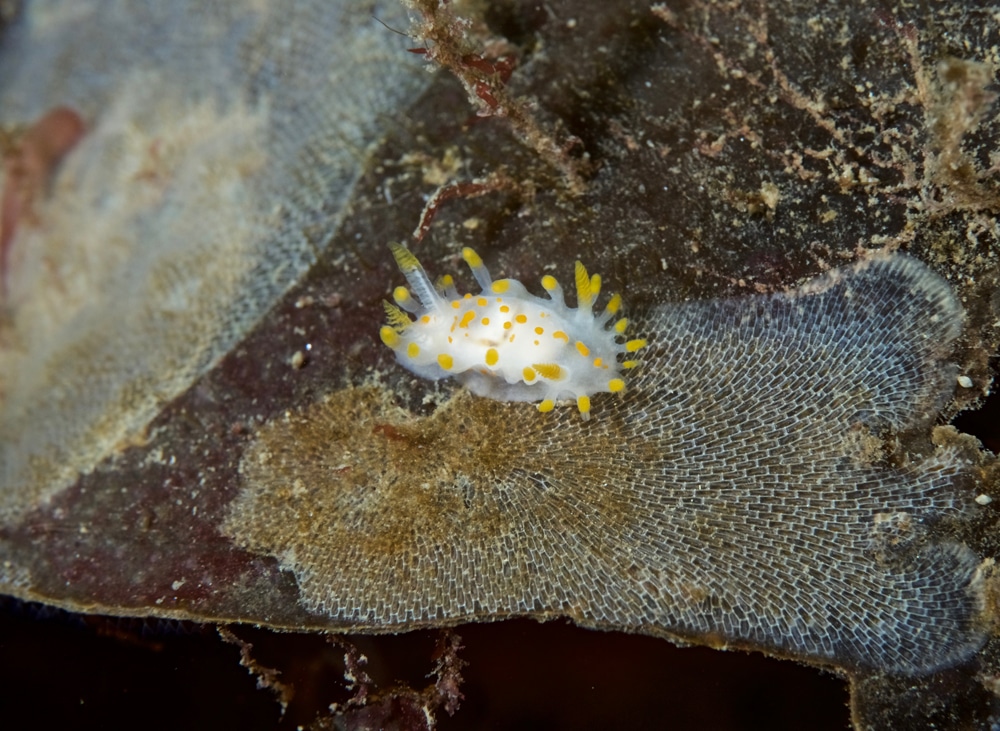
Dive 9: Pinnacle, Farganlach Point, Rathlin Island
Site description:
The north side of Rathlin island is known for is deep walls that go from a few meters down to over 100m. The north has shallow gullies and pinnacles going down onto the main wall and after the first 16m of kelp covered rock the walls become sheer and are covered in a huge amount of life all the way from the kelp line at 18m to the depths.
The Dive:
We waited for slack tide (a must on spring tides) and entered the water on the pinnacle. After dropping down about 18m we found the kelp stopped and the wall began. Despite the slack tides, the currents were having a party up, down and sideways on the wall and so we took the excellent advice of our skipper and stuck close to the wall to avoid the worst of it. The visibility was good again and the walls absolutely packed with life, dead men’s fingers, jewel anemones, white striped anemones, Devonshire cup-corals and a variety of sponges covering every inch of rock. We also had a visit by a compass jellyfish, albeit briefly, which rocketed up past us in the current. We had a good dive, sticking to the wall and moving gently along with the flow. The diving here is excellent and definitely lived up to it’s reputation!
Mike’s thoughts:
The diving potential in this area seems enormous, with seven miles of sheer walls to explore; in our case I’m glad we stayed fairly shallow and within a small area of the drop off point. While not quite approaching a washing machine, the currents throughout the dive were strong and constantly changing making buoyancy control very challenging. Nevertheless, by hugging the wall closely we could enjoy inspecting the life on the wall as we drifted by. Again, the density of life was impressive with a wide variety of creatures from tiny cup corals to large lobsters packed into every nook and crevice. The huge shoals of pollock and coley streaming by us were more evidence of just how nutrient-rich the local waters were. The conditions on our dive were definitely for more experienced divers but I thoroughly enjoyed my introduction to boat diving in Northern Ireland!
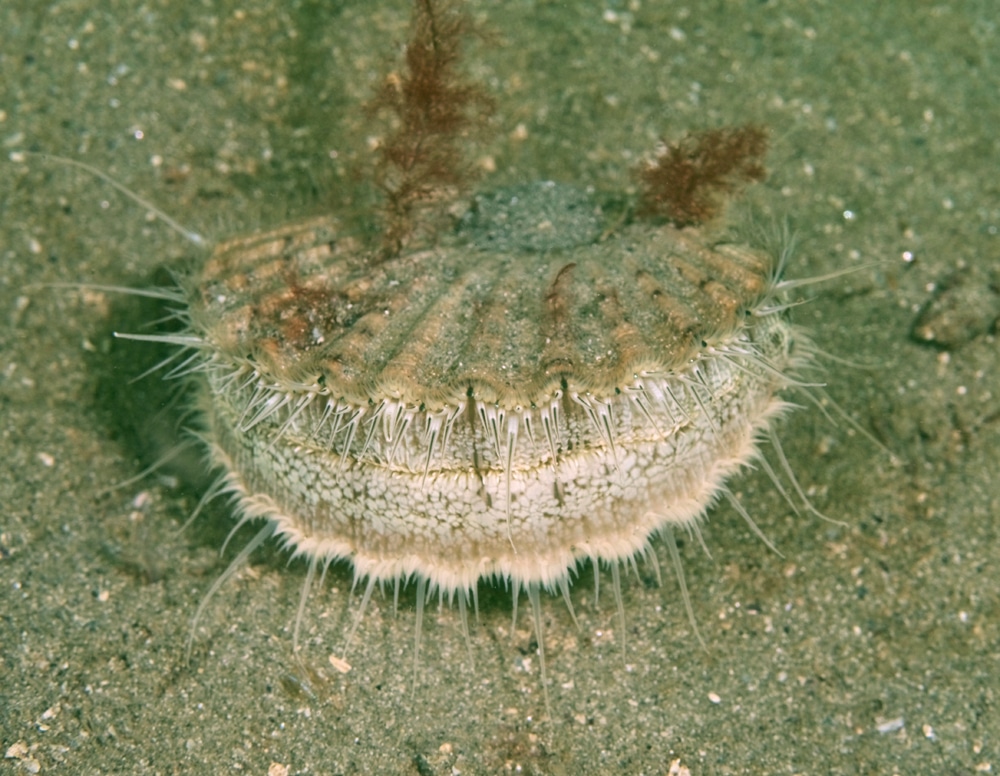
News
Book Review: Fire on Monroe Bravo by Fred Lockwood

Fire on Monroe Bravo is the latest book in the Jack Collier series by Fred Lockwood. Our story begins with our lead characters, Jack and Sandro, owners of Marine Salvage & Investigation Company, arriving on the Monroe Bravo Oil & Gas Platform in the North Sea. Having secured a contract for their vessel the MV Stavanger to act as support ship to the platform for TransGlobal Oil, our protagonists are on a celebratory visit.
However almost as soon as they arrive a series of explosions rock the platform, causing huge damage, loss of life and the very real danger of a massive human, ecological and financial disaster.

As the danger mounts for both our heroes and the surviving workers, Jack and Sandro will have to escape the inferno, all while trying to save the platform and the men still trapped unable to help themselves.
The disaster sets the scene for the unfolding story lines following the fate of the platform and our main characters, the police investigation into a suspected terrorist act and the actions of TransGlobal Oil as they attempt to navigate the pubic outcry and financial repercussions.
In his eighth book, Fire on Monroe Bravo, Fred Lockwood delivers an explosive thriller, with plenty of above and in-water drama, and our heroes fighting for survival, what more can you ask for?
We thoroughly recommend this read and look forward to the next in the series. For more information about his book series, you can check out the reviews of his previous books here on Scubaverse.
- Title: Fire On Monroe Bravo
- Author: Fred Lockwood
- ISBN: 979-8325324536
Available in a paperback version and for Kindle from Amazon and book stores.
Blogs
Alonissos: The complete diving destination (Part 1)

In June we were incredibly fortunate to be invited to dive in Alonissos, a small Greek Island in the Sporades island chain located in the North Aegean Sea. While I have long been a big fan of the Greek Islands as a great holiday destination, I had not had the opportunity to do any diving on previous visits and Mike and I were extremely excited to see what Alonissos had to offer both above and below the surface!

The Sporades are easily accessible via the airport in Skiathos (the first island in the chain), which is served by Jet2 flights from all major UK airports from May through October. Numerous ferries and charter boats make island hopping from Skiathos Town a breeze. After an hour boat ride, the picturesque port of Patitiri was a wonderful introduction to Alonissos, where we were met by our gracious hosts Kostas of Albedo Travel and Dias of Alonissos Triton Dive Center. Mike and I were delighted to be staying at the Paradise Hotel, aptly named for its stunning views over the sea and great location for walking to the waterfront.

Alonissos is beautifully situated in the National Marine Park of Alonissos and the Northern Sporades, the largest marine protected area in Europe. The surrounding seas offer fabulous marine life, including incredibly rare species such as the Mediterranean monk seal. They boast deep walls covered in gorgonians and sponges, stunning topography with caverns, swimthroughs and pinnacles, and the first accessible ancient shipwreck from 500BC!

In locations where historical sites have been reported, the waters are largely restricted, but with collaboration between government, underwater archeologists and dive centres, incredible underwater museums are being created for a truly unique diving experience. Alonissos is home to the first of these, the Ancient Shipwreck of Peristera Accessible Underwater Archeological Site. The chance to dive into history (along with reports of healthy reef life and amazing underwater topography) meant Mike and I were keen to get in the water.

Our introduction to the diving around Alonissos was at the Agios Georgios Pinnacles, in the channel between Alonissos and Skopelos. This fantastic site was named “The Chimney,’ and proved to have a huge amount to see. We got to a decent depth here (over 25m), and marvelled at a colourful reef wall with a wonderful swim through whose rocky walls were absolutely covered with life. As well as brilliant topography there was no shortage of macro life here. We saw numerous nudibranchs, five different species in total. The second dive at Mourtias reef nearby was a shallower dive along a nice wall with lots of crevices. Several moray eels and grouper called this site home. We enjoyed looking in the crevices for lobster and smaller benthic life, such as cup corals and tunicates.

Our itinerary allowed us two dives a day with afternoons left to explore the island with our hire car and evenings to enjoy the famous Greek hospitality. This proved to be a lovely mix of in-water and land based diversions.

The next days diving to the Gorgonian Gardens and Triton’s Cave was to be even better! These two stunning sites are nothing short of fabulous. The Gorgonian Gardens was a deep wall near to the Agios Georgios islands. The ever-present currents in this deep channel meant that the sea life was amazing … the namesake Gorgonian sea fans dotted the wall at a depth of 30 to 50 meters, getting ever larger the deeper we went. Above 30m was by no means less beautiful, with sponges, corals, scorpionfish, moray eels and some rare and colourful nudibranchs.

The second shallower dive of the day was to Triton’s Cave or the Cavern of Skopelos, on the east side of that island. The spectacular rock formations had wild striations both above and below the water making a truly epic topography. The cavern entrance was at 14m, and big enough for a buddy pair, winding up to 6m and passing two beautiful windows out into the blue. Emerging from the cavern, the light at the shallower depths and the incredible rock formations made for a fantastic gentle swimming safety stop and we all surfaced by the boat with massive grins.

Check out our next blog :Alonissos: The complete diving destination (Part 2)” to hear about our amazing dive on the 2500 year old Peristera Wreck!
Thanks to:
Alonissos Triton Dive Center https://bestdivingingreece.com/
Albedo Travel https://alonissosholidays.com/activities/
Paradise Hotel https://paradise-hotel.gr/
Alonissos Municipality https://alonissos.gr/en/
-

 Blogs2 months ago
Blogs2 months agoDiving With… Nico, Ocean Earth Travels, Indonesia
-

 News1 month ago
News1 month agoMurex Bangka Announce New Oceanfront Cottages & Beachfront Dining
-

 Blogs2 months ago
Blogs2 months agoA new idea in freediving from RAID
-

 Marine Life & Conservation1 month ago
Marine Life & Conservation1 month agoIceland issue millionaire whale hunter a licence to murder 128 vulnerable fin whales
-

 Marine Life & Conservation2 months ago
Marine Life & Conservation2 months agoThe Shark Trust Great Shark Snapshot is back
-
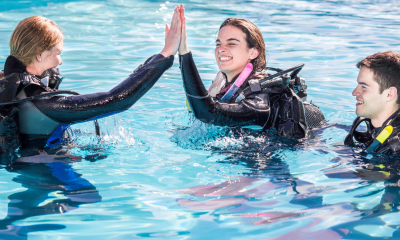
 News3 months ago
News3 months agoCharting New Waters; NovoScuba Goes Global with the Launch of their Revolutionary Dive Training Agency!
-

 Gear News1 month ago
Gear News1 month agoNew Suunto Ocean – a dive computer and GPS sports watch in one for adventures below and above the surface
-

 Marine Life & Conservation Blogs2 months ago
Marine Life & Conservation Blogs2 months agoBook Review: Plankton















